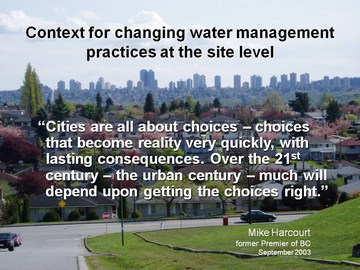Historical / Regulatory Context for “Integrated Stormwater Management Plans” in British Columbia
Note to Readers:
During the November-December 2010 period, the Water Sustainability Action Plan for British Columbia released a series of five articles that are designed to inform local governments and others about a ‘course correction’ for Integrated Stormwater Management Plans (ISMPs). The series describes:
- what ISMPs are;
- how local governments can do more with less; and
- how local governments can ensure ISMPs are outcome-oriented.
The first in the series provides regulatory and historical context, identifies introduces guiding principles for implementing change on the ground, explains what outcome-oriented means, and sets the stage for the four stories that follow.

Watershed-Based Planning in the Local Government Setting
Use of the ISMP term is unique to British Columbia. First used by the City of Kelowna in 1998, the term quickly gained widespread acceptance by local governments and environmental agencies to describe a comprehensive approach to watershed-based planning in an urban context.
The Province recognizes that communities are in the best position to develop solutions which meet their own unique needs and local conditions. Historically, then, the Province has enabled local government by providing policy and legal tools in response to requests from local government.
The enabling approach means the onus is on local government to align local actions with provincial and regional policies, and embrace shared responsibility.
Plan at Four Scales – Regional, Watershed, Neighbourhood and Site
When the Province released Stormwater Planning: A Guidebook for British Columbia in June 2002, the ISMP approach became a recognized provincial process. Although Integrated Watershed Management Plan better described what was envisioned at that time, use of IWMP was not an option because the Province had an existing IWMP process for natural resource management in wilderness watersheds.
In 2002, the Guidebook introduced a set of five guiding principles for ISMPs (scroll down to view image). These are captured by the acronym ADAPT, where the “P” stands for Plan at four scales – regional, watershed, neighbourhood and site.
In integrating actions at four scales, the intended purpose of an ISMP is to provide a clear picture of how local governments can be proactive in applying land use planning tools to protect property and aquatic habitat, while at the same time accommodating land development and population growth.
To Learn More:
To read the complete story posted on the Rainwater Management Community-of-Interest, click on Story #1 in the ISMP Course Correction Series: Re-Focus on Stream Health and Watershed Outcomes
For more information on the historical / regulatory context as presented in the Guidebook, click on the following link to download Chapter 1 – Land Use Change Drives Stormwater Management

Posted November 2010

